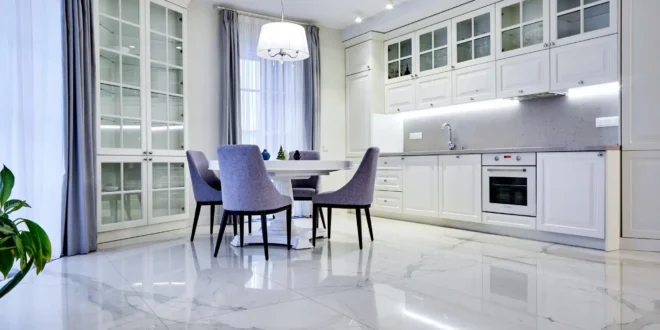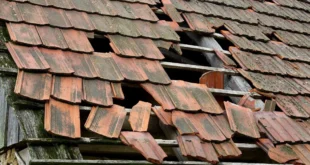Choosing the right flooring material is a critical decision for any homeowner or designer aiming to create both a functional and aesthetically pleasing space. Two popular options in luxury flooring are travertine and marble.
Each presents a unique set of characteristics in terms of durability, appearance, maintenance, and cost. In this comparison, we’ll explore the pros and cons of travertine vs marble to help you decide which may be the better choice for your flooring needs.
Pros of Travertine Flooring
Travertine flooring, a distinguished selection for numerous architects and home renovators, epitomizes a harmony between natural aesthetic charm and enduring functionality. Its commendation is not unwarranted, given its considerable attributes that span from its thermal endurance to its visually pleasing characteristics, which naturally enhance the allure of any space.
Predominantly, the advantages of travertine pavers manifest through their unparalleled versatility in design, exceptional durability over time, and their capacity to age with a grace that retains their elegance. These facets collectively underscore the reason travertine remains a perennial favorite in the realm of luxury flooring.
Natural Beauty
Travertine comes straight from the earth, giving it a unique look that you just can’t fake. Each piece tells its own story with cool patterns and colors that vary from tile to tile.
This means when you lay down travertine floors, you’re getting a one-of-a-kind look that adds charm and character to your home. Plus, its natural vibe can make any space feel more welcoming and warmer.
Durability
Travertine is tough, really tough. It can last for decades if you take care of it right. Walk on it, drop things on it, spill stuff – it holds up well against daily life’s messes. Plus, travertine doesn’t get cold feet, meaning it stays warmer underfoot compared to other stones.
This makes it a solid choice for places where you’ll be walking barefoot, like bathrooms or kitchens. But remember, while it’s strong, it still needs some love with regular sealing to keep it looking its best.
Non-slip Texture
Now, for those of us who are kind of clumsier or have speedy little ones or pets zipping around, travertine’s got something else pretty neat. The thing is, it’s not super slippery.
Its surface has this natural grip to it, which is pretty awesome if you think about it. No more whoopsie-daisies in the bathroom or kitchen where things can get a bit like a slip ‘n slide sometimes. Travertine keeps you standing tall, not doing unintentional splits. How cool is that?
Heat Retention
Okay, folks, here’s the deal with travertine and staying cozy. This rock star floor material is pretty rad when it comes to soaking up and hanging onto warmth from the sun or your toasty indoor heating. Think about those chilly mornings when your feet hit the floor; with travertine, it’s like walking on sunshine, even if it’s frosty outside.
This makes it a superhero in places that get a bit nippy but still want to keep things feeling snug. Bonus: it means your toes won’t freeze off when you’re sneaking to the kitchen for a midnight snack. Pretty neat, huh?
Cons of Travertine Flooring
Now, don’t get it twisted; travertine is pretty cool, but it’s not all sunshine and rainbows. Just like that superhero movie where the hero has that one weakness, travertine’s got its kryptonite to deal with.
Before you go all in and deck out your place, let’s peel the curtain back and check out the not-so-glam parts of having travertine under your feet. Buckle up, because here comes the dirt on the cons of picking travertine for your floors.
Porous Nature
Travertine, you know, is kind of like a sponge. It’s got lots of tiny holes all over it. This means if you spill something like juice or sauce, it could soak in and make a stain.
You’ve got to seal it – think of it like putting a coat on to protect it from the rain. This way, it stays looking good. But you’ll need to do this sealing thing now and then to keep it safe.
Maintenance Requirements
Keeping travertine looking its best does require some effort. First off, you need to seal it regularly to prevent stains and damage from spills. Think of this like giving your floors a protective shield. You’ll also want to clean up any spills quickly, so they don’t have time to sink in.
For everyday cleaning, a simple dust mop or a soft, damp cloth works best to keep dirt and grime at bay. Avoid harsh chemicals or abrasive cleaners, as they can scratch or damage the stone. With a little care and attention, your travertine floors can keep looking fabulous for years to come.
Heavy Weight
Travertine is heavy. Like, seriously heavy. When you pick this for your floors, you have to make sure your place can handle it. It’s not like those lightweight vinyl or laminate options.
This means if you’re thinking of laying travertine upstairs or in a spot where weight could be a problem, you might need to check with a professional first. They can tell you if your structure is strong enough to support all that weight without any issues.
Pros of Marble Flooring
Alright, shift gears and chit-chat about marble-another swanky floor choice that’s got folks oohing and aahing. Marbles like that glam star from old Hollywood, dripping in class and sophistication. It lights up any room it graces, from swanky entryways to posh bathrooms, making them look downright luxurious.
But hey, marble isn’t just a pretty face. It’s got a few tricks up its sleeve that make it worth considering for your crib. Buckle up, as we’re about to deep dive into the cool perks of marbling up your floors.
Luxurious Appearance
Marble floors shout luxury the moment you step into the room. They shine and sparkle, making any space look high-end and expensive. Each marble piece is different, with unique veins and patterns that add elegance and beauty.
This means no two marble floors are the same, giving your home a unique and classy touch. People love marble for its sophisticated vibe that can instantly elevate the look of any interior.
Heat Resistance
Marble is cool when it comes to dealing with heat. It doesn’t get all worked up and change color if you put hot pots or pans on it. This makes marble great for kitchens or places where things can get a bit hot.
It can handle the heat without losing its cool look. Plus, if you live somewhere warm, marble feels nice and cool underfoot, making it a chill choice for beating the heat.
Adds Property Value
Marble isn’t just about looking pretty; it’s an investment in your property. Installing marble floors can boost your home’s value big time. Why? Because marble screams luxury and quality. When people see marble floors, they think upscale, which can make your place more appealing to potential buyers if you decide to sell.
It’s like, with marble, you’re not just upgrading your floors; you’re upgrading your whole home’s market appeal. Plus, because marble is so durable, it’s a long-term boost in value, not just a quick fix.
Cons of Marble Flooring
Okay, gang, it’s time to spill the tea on the flip side of having marble floors. Sure, they’re all shiny and fancy, making your place look like a castle, but it’s not all glitter and gold. Marble, for all its cool points, has some bits that might make you go, “Hmm?”
Before you jump on the marble bandwagon, let’s get into the nitty-gritty of what might not be so peachy about choosing marble for your floors. Time to peek behind the curtain and see what’s up with marble’s not-so-fun side.
Scratch & Stain Propensity
Marble, pretty as it is, has a bit of a problem. It doesn’t take kindly to scratches or stains. If you’re not careful, even something as small as dropping a fork can leave a mark. And don’t get me started on spills!
Things like wine or oil can sneak into those gorgeous veins and leave a stain that’s tough to get out. You’ve got to be on your toes, cleaning up messes quickly and maybe even thinking about sealing it to give it a fighting chance.
Regular Maintenance
Alrighty so here’s the lowdown on keeping those marble floors looking all snazzy. Think of marble like that high-maintenance friend who needs lots of TLC. First off, you got to wash them gently – none of that harsh scrubbing or crazy chemicals.
Just a nice, soft mop and some warm, soapy water will do the trick. And about those spills, you got to jump on them quickly! Marble ain’t too forgiving with stuff like soda or coffee; it can get all stained and sad-looking if you don’t clean it up pronto.
Plus, now and then, you’ll want to treat your marble to a spa day with some special sealer to keep it from getting all scratched up or stained. Yeah, it’s a bit of a hassle, but hey, all that work keeps your floors looking oh-so-fancy!
Expense
Marble, with all its glamour, comes with a price tag to match. It’s more expensive than many other flooring options out there. From buying the materials to getting it installed, the costs add up quickly. This is because marble is a natural stone that needs to be quarried, transported, and then finely crafted into tiles or slabs.
Plus, if you want those fancy finishes or custom cuts, that’s going to cost extra too. In short, choosing marble means you’re ready to splurge a bit for that luxe look.
Choosing Between Travertine and Marble
When determining whether travertine or marble is the better choice for your flooring, consider the climate of your home, your lifestyle, and your budget. Travertine offers a warm, rustic look with excellent durability and non-slip properties, making it ideal for households with pets or children.
Marble, on the other hand, provides a cool surface and brings an undeniable touch of elegance and luxury to any space, enhancing the overall value of the property.
Installation and Maintenance Considerations
Both travertine and marble require professional installation to ensure that the flooring is properly sealed and fitted. While travertine needs periodic sealing to protect its porous surface from stains and damage, marble requires regular polishing to maintain its exquisite shine and prevent scratches.
It’s crucial to factor in these ongoing maintenance needs and costs when choosing between the two materials. Ultimately, both travertine and marble offer unique benefits and add undeniable value to any home, making them worthy contenders for your flooring needs.
So, take some time to consider the pros and cons and choose the option that best fits your style, budget, and maintenance preferences.
Environmental and Health Considerations
Travertine and marble, they’re both from the Earth, but grabbing them to stick in our homes isn’t super green. When folks carve out big chunks from the ground, it can hurt natural spots, and all the trucking around of heavy rocks isn’t great for air clean-up.
Plus, sealants and cleaners we use to keep them shiny might not be besties for the planet or our health. These can have yucky stuff in them that goes into the air we breathe. Using less mean stuff and more green, safe ways to clean can help.
Learn All About Travertine Vs Marble
Alright, folks, here’s the skinny on travertine vs marble. Both rocks are pretty cool in their ways. Travertine’s all rustic and tough, a true buddy for houses that have lots of action. Marble? It’s the kind of classy that dresses up any joint, making it look sweet and chic. But hey, they both need some looking after, and it isn’t exactly cheap to have them around.
Plus, pulling these rocks out of the Earth and keeping them spick and span isn’t the best for our big green world. Just remember, whether you go with travertine or marble, you’re jazzing up your space big time.
Did you find this article helpful? Check out the rest of our blog.
 SlushWeb Bringing Facts to Light
SlushWeb Bringing Facts to Light



